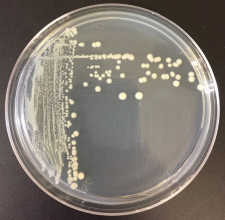Host Basics-Arthrobacter globiformis

An Introduction to the Host Bacteria, Arthrobacter globiformis
As a network of researchers, SEA-PHAGES explores the genetic diversity and relationships of populations of bacteriophages that infect Actinobacteria, incluidng the bacterium Arthrobacter globiformis. There are many different strains of Arthrobacter globiformis. (isolated from different environmental samples). The Arthrobacter globiformis strain widely used in SEA-PHAGES is called Arthrobacter globiformis B2979-SEA, and is made available to you via the USDA culture collection. If you intend to isolate phages using this bacterium, then this will be your ‘host’ for phage isolation.
Arthrobacter globiformis is one of over 70 species that make up the genus Arthrobacter, classified within the phylum Actinobacteria. Arthrobacter globiformis is a gram-positive soil organism, whose relatives are well equipped to breakdown various hydrocarbons. Arthrobacter arilaitensis, for instance, grows on the surface of cheese and catabolizes the fatty acids, amino acids, and lactic acid present, contributing to the color and flavor of the cheese. Other Arthrobacter species are capable of breaking down compounds such as hexavalent chromium, which is a carcinogen, suggesting a potential use in bioremediation (i. e. the breakdown of pollutants). The specific Arthrobacter strain you will use, alongside its relatives, has been found to produce penicillin derivatives and aspartic decarboxylase.
Arthrobacter globiformis will grow and divide on many nutrient-rich media. In your research, you will grow Arthrobacter sp. on PYCa media and at 30 - 37 ˚C. Under these conditions, Arthrobacter globiformis grows rapidly, dividing approximately once every 2 - 3 hours. This means that it typically takes about 3 days for an individual cell to form a colony on an agar plate. However, when
preparing a bacterial lawn, you can start by adding many bacterial cells (e. g. 107 or more) so that a lush lawn grows within 1 – 2 days. For reproducibility of experiments, it is important that cultures used for a given set of experiments be prepared at the same temperature.
Arthrobacter globiformis colonies are white to tan in color, smooth and glossy. A liquid culture of Arthrobacter globiformis inoculated from a single colony will take 2 days to form a saturated liquid culture, exhibiting a tan color. The strain you will work with is not inhibited by the antifungal
cyclohexamide. Therefore, this can be added to the growth media to prevent other microorganisms from growing in your cultures.
On average, 30 % of attempts to isolate phage from soil by enrichment with Arthrobacter globiformis yield phage.
 |
|---|
Figure 4.0-4. Arthrobacter globiformis. growing on an agar plate. |
If you are using this bacterium as your host for phage isolation, refer back to the list below for the specific growth and culture requirements for your experiments.
Growth media: PYCa
Growth temperature: 22 - 37 ˚C.
Antimicrobials: cycloheximide (10 μg/ml)
Phage Buffer: 10 mM Tris (pH 7.5), 10 mM MgSO4, 68 mM NaCl, 1 mM CaCl2, (10% glycerol, optional)
Restriction Enzymes: BamHI, ClaI, MseI, NspI, and SacII.
Note: Isoschizomers, which are different restriction enzymes that recognize the same DNA sequence, may be used in place of any of the enzymes listed above.